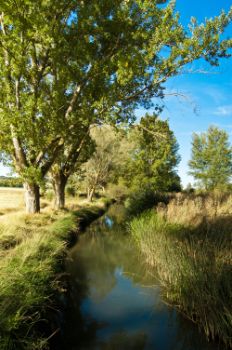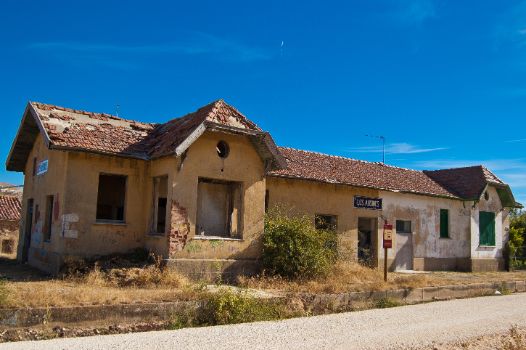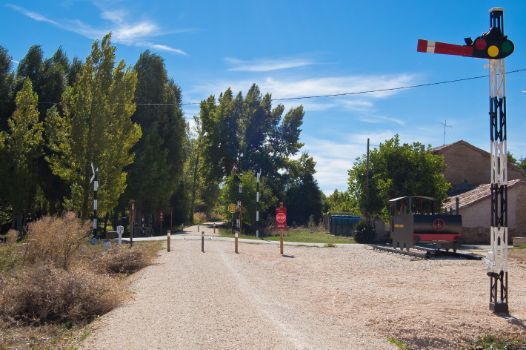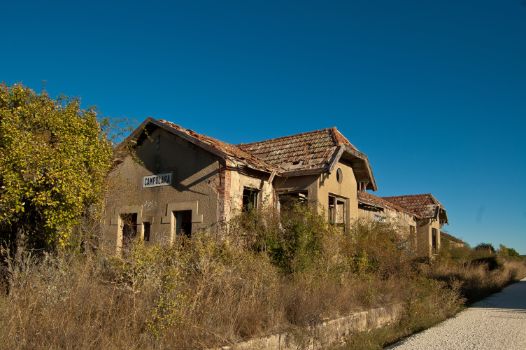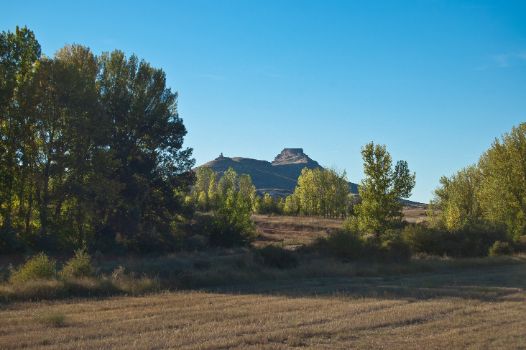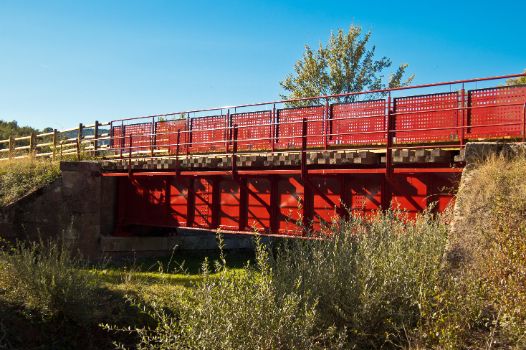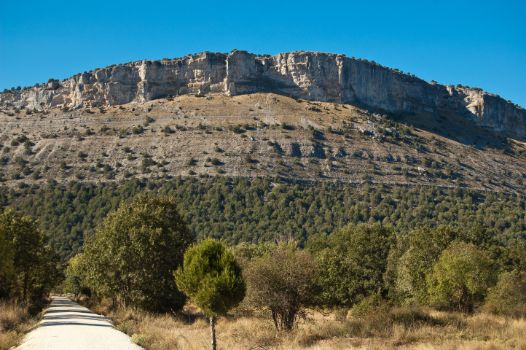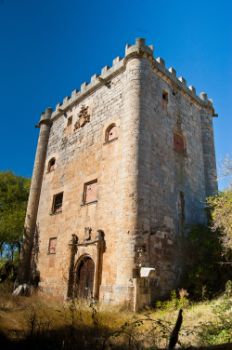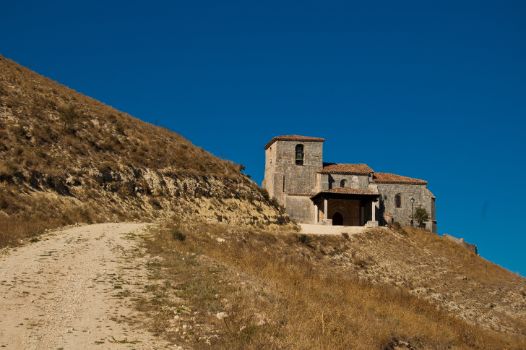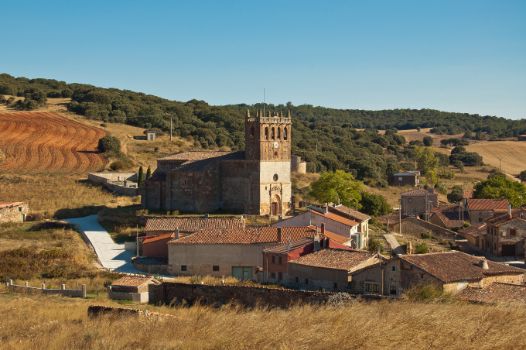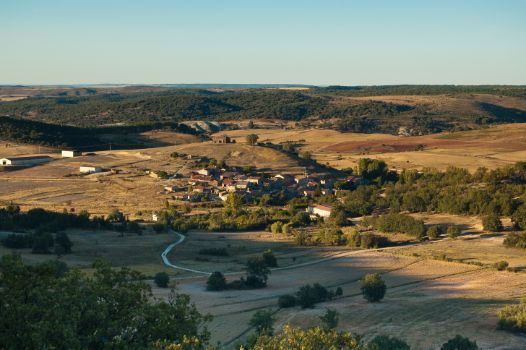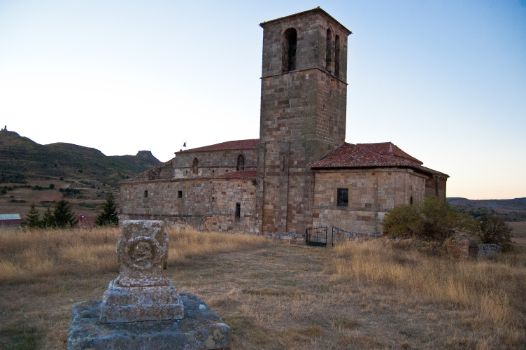Net of Natural
Trails

Santander-Mediterráneo Nature Trail. Cojóbar-Cascajares de la Sierra section
Description
Peñalara, an unchanged vestige of the Santander - Mediterranean Sea railway route.
This section full of history and pre-history starts in the town of Cojobar, just a few kilometres south of the capital of Burgos. This has numerous findings of dinosaur remains and was vestige, according to that related in Cantar de Mio Cid, of the exile of Rodrigo Díaz de Vivar: El Cid.

This, almost 37 kilometre-long, section of the old Santander - Mediterranean Sea railway route between Cojobar and Cascajares de la Sierra, starts in the town of Cojobar (Burgos), specifically next to the end of Burgos-Cojóbar section. A few metres after the beginning of the route, the old station of Cojobar is reached. After passing the first kilometre of the stage, a crossroads invites for a visit to the town of Olmosalbos, where the Torreón de los Gamarra tower stands out.
Continuing along where the trains once travelled, the traveller arrives at the town of Revillarruz, where the church of Natividad de San Juan Bautista dominates the landscape. The route passes parallel to the River Ausines and eventually crosses this via a bridge for said purpose, enjoying the abundant riverside vegetation. Lined by rain-fed crops, wind turbines for electric energy production rise up from the small hills.
The town of Los Ausines, with the neighbourhood of Quintanilla and a large open air quarry welcome the visitor, who can find a Rest Area shortly after the old station of Los Ausines. Los Ausines is made up of three neighbourhoods, which the route leaves on the left, passing firstly past the already mentioned neighbourhood of Quintanilla with the church of Santa Eulalia and the medieval bridge over the River Ausines. Coinciding with kilometre point 8, the neighbourhood of San Juan is passed on the left, and soon after so is the Sopeña neighbourhood.
The route advances in parallel to road BU-P-8012 and after kilometre point 12 the Revilla del Campo Rest Area is reached. This has sports facilities and some of the original elements from the railway line have been conserved.

The town of Revilla del Campo is soon reached, with a neighbourhood on each side of the trail. After leaving this town, the Nature Trail continues in parallel to the road, passing through various areas with evergreen oak (Quercus ilex) scrubland and riverside vegetation dominated by white poplars and aspen (Populus sp.) due to the humidity provided by the River Lara. Once kilometre point 16 is reached, the road that leads to the town of Quintanalara is crossed. The entrance to said town pays tribute to the Santander- Mediterranean Sea, with various elements of this railway route. A new crossroads indicates the possibility of visiting the town of Torrelara, for a few kilometres prior it coincides with the Camino del Cid (GR-160), emulating Rodrigo Díaz de Vivar’s trip in his exile, according to that stated in Cantar de Mio Cid.

The Pyrenean and Gall oaks make their presence known, whilst Peñalara can also be seen for the first time, this is a highly important orthographic milestone along the trail. Afterwards, the small town of Paules de Lara is left on the right, and to the left the town of Peñalara and the ruins of the Castle of Lara can be appreciated.
After kilometre point 24, the road that leads to Aceña de Lara is crossed, and two kilometres afterwards the church of Lara de los Infantes can be seen. Shortly after crossing the road that enters Campolara, the route reaches the old station of Campolara, whose buildings are true vestiges of abandonment and the passing of time. After this succession of towns, the Nature Trail continues its route through agricultural land.
Passing past kilometre point 30, the bridge over the River Valpariso is crossed with a landscape of white poplars (Populus alba), acting as a prelude to the town of Villaespasa, with its church of Santa Eulalia dominating the scenery. Two kilometres later, the traveller faces the final part of this section, starting with a smooth decline that bids farewell to the omnipresent Peñalara every time a backwards gaze is made.

The River of San Martín is crossed via a bridge for said purpose, with the route heading southwards. Specimens of Spanish juniper (Juniperus thurifera) start to appear as the trail nears the Protected Natural Area of Los Sabinares de Arlanza (SCI and SPAB), at the end of the trail.
Immediately after the crossroads that heads to the town of Cascajares de la Sierra, a bridge over the River Salcedal is crossed. In these last stretches of the route, dense Pyrenean oaks accompany the traveller to the left of the trail, coming to an end at the Cascajares-Hortigüela stop which has an interpretation panel and Rest Area.
Sites of interest
Puntos de interés
Culture
- Ermita visigótica
- Ermita de San Cristóbal
- Ermita de San Olav
- Ermita de San Roque
- Ermita de San Juan
- Ermita de Ntra. Sra. del Castillo
- Torreón de los Gamarra
- Monasterio de San Pedro de Arlanza
- Castillo de Lara
Hydrography
Infrastructure
- Estación de Los Ausines
- Aerogeneradores
- Estación de Campolara
- Estación de Cojobar
- Apeadero de Cascajares
Municipality
- Revilla del Campo
- Torrelara
- Humienta
- Quintanalara
- Jaramillo Quemado
- Barrio de San Juan (Los Ausines)
- Barrio de Sopeña (Los Ausines)
- Cascajares de la Sierra
- Aceña de Lara
- Paúles de Lara
- Campolara
- Vega de Lara
- Cojobar
- Barrio de Quintanilla (Los Ausines)
- Cubillejo de Lara
- Villaespasa
- Quintanilla de las Viñas
- Revillarruz
- Lara de los Infantes
Orography
Hostel
Vegetation
Profile

MIDE (Method for the Information of Excursions)
(Calculated according to the MIDE criteria for an average excursionist with a light load)
Highlights
Further information
Following the footsteps of El Cid
There are many points along the old Santander - Mediterranean Sea railway route, and thus this Nature Trail, that coincide with the Camino del Cid trail. This route relives that undertaken by Rodrigo Díaz de Vivar, according to the anonymous work the Cantar de Mio Cid written at the end of the 12th or beginning of the 13th century. Due to various warlike events, El Cid Campeador was punished to exile and had to leave his family and home town behind, abandoning the kingdom in the short period of 30 days. The route taken was that narrated in the literary work, albeit there are areas that are not well described, and as such routes have been adapted depending on the means by which they are undertaken.



